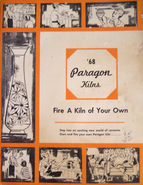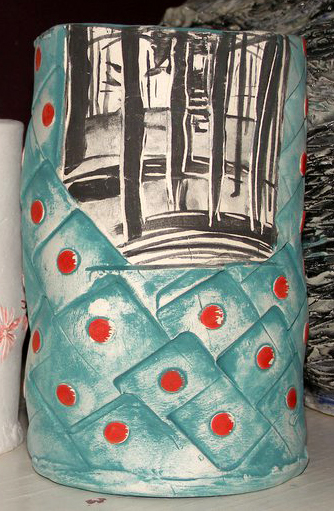|
This month’s “Artist Spotlight” is on Eliot Joanna Angell. She is a ceramic artist, a professor of ceramics, printmaking and foundations at the University of South Carolina Beaufort and an instructor of printmaking and ceramics at Armstrong State University in Savannah. We traveled to Joanna’s delightful home on the south side of Savannah to ask her a few questions about her background in clay. We ended up talking well into the night at her kitchen table as we drank from beautiful mugs made by well-known potters. Joanna opened up her cupboards to let us peruse the pottery there and allowed us to explore her studio that is tucked into her backyard. It was a great time getting to know another one of Savannah’s clay artists, and we are eager to share her story.
Joanna returned to New Jersey to finish her English degree and worked awhile on Wall Street and at an architectural firm. She decided to apply for her master’s degree at the University of Georgia to study printmaking. Her final two semesters of school, Joanna enrolled in ceramics classes, studying with Ron Meyers. Ron, a straight-forward cigar smoker with a sparkle in his eye, was another great clay influence in Joanna’s life. She was drawn to “his expression of immediacy and vitality in pots that aren’t wholly smooth or that have been nudged off center.” Joanna says, “I know he can throw a perfect pot, so I excused some of my sloppiness in the beginning thinking, ‘I studied with Ron you know,’ but there’s no excuse. I’m still earning the right to do that, and when throwing or carving, I still want perfection. Ultimately it’s the pursuit of beauty and expression, right?” I’m still earning the right to do that, and when throwing or carving, I still want perfection. After graduate school, Joanna moved to Walterboro, SC, where she started a family and owned a gallery called SAJA—a name blended from her and her daughter’s names, Sarina and Joanna. She recalls, “I had my daughter and owned my little gallery, but I wasn’t disciplined enough to keep retail hours. I was raising a child, and I didn’t want to stay indoors all the time.” Joanna home schooled her daughter, so when it came time to enroll in high school, Sarina applied to Savannah Arts Academy and was accepted. She and her daughter moved back to Savannah, right next door to her childhood home, and Joanna secured a position at Armstrong teaching a printmaking course. She was later offered a part-time teaching position USC Beaufort in ceramics and foundations, then became full-time and added printmaking to her teaching schedule. She’s been teaching there for about four years now. Joanna has two distinct bodies of work. The first explores function in the form of mugs and bowls, and has most recently featured her bird bowls—vessels and planters whose wings nurture the space within. The second engages the form of the dress both in two-dimensional media and ceramic sculpture. Dresses appear as ornamental shaped tiles and as small negative spaces hidden in vast abstracted landscapes. Flowers, words and figures define shaped clay tiles and approach the definition and identity of the feminine, real or perceived. Now, let's move on to the interview. We wanted to ask Joanna questions that many clay artists face during their careers. Joanna provided some great insights on how she approaches her studio work and what she feels our community needs in Savannah. Why did you gravitate towards clay when your concentration in school was in printmaking? A lot of my prints at the end of grad school were abstract spaces, but I always felt that I was entering the space of the picture plane—not that it was a flat something I was decorating; it was more sculptural in my head. I still make a lot of abstract images on tiles and surfaces, but I started trying to ask myself who was in that space I was creating. So I started making these dresses as shaped canvases. They were flat, with a little movement back then, but those were sprigged and stamped—similar processes to printmaking because you can repeat forms. In one exhibition in Walterboro, I had a friend who asked, “Who is in these dresses?” Which is a great question. It’s not really me, so who is it? The dresses come from dreams of flight, where I want to represent a figure, and it also expresses the loss of my mother. I was there with her when she was in the hospital and I could feel her passing; so I think I’m going for that question of what else is in this space with us. I tried to give these dresses names, to identify and express symbolically how this woman’s skirt would flip. These forms have come off the wall, and now I want to make large flying forms. I’m still on a path with those dresses. I have to answer a question that’s there and figure out the driving force of the sculptures.
How has your work changed over time? The dresses I make are coming “off the wall” and into the “round”, and I’m working larger. Since I’ve made so very many bird bowls, I believe I’m finally refining the form. How do you get out of your head in the studio? Yoga usually, but recently I’ve just been inspired to work. I think you just have to let it all go, and that helps to shut out some of those things. Who are a few of your “clay heroes?” Ron Meyers, Andy Nasisse, Cristina Córdova, Beth Cavener Stichter, Edna Arnow, Cynthia Bringle, Nick Joerling and Paulus Berensohn. Why are the ceramic arts important in Savannah? Making and makers are important in any city. Making attaches us to our humanity. The word “craft” has the same root as “create” and is vital to human experience. (What child doesn’t want to build a sand castle - or a Minecraft city?) I believe it’s innate. And when we as educators or artists can spark interest in the handmade, we invite participation in the whole human experience, the creative. Surely we all need to create more than we destroy. Also, “big” art – paintings in museums, for instance, is sometimes elevated by critics and viewers to seem inaccessible or that only super-humans could have created it. We break it down. Pots especially, which can be held and used, are intimate, inclusive and accessible. How can we make ceramics a bigger part of daily life? Collaboration with schools will help make ceramics a bigger part of daily life. People love understanding that things are economically good for the environment and craft is a viable industry—it brings money to cities.
How do you balance making work that is important to you versus work that the community responds to and buys?
Good question! I currently have enough bird bowls so that I can stop producing those for a while and focus on some larger sculpture. How do you balance family, business and studio life? With a sense of humor!
7 Comments
Juanita Hale
2/24/2016 07:06:23 pm
Was your mother from chicago? was your father Joe Diehl?
Reply
7/26/2016 08:34:57 pm
Juanita! Yes! I remember my mom speaking of you!
Reply
Joanna
6/22/2018 02:18:59 pm
Hi, Juanita. I would love to be in touch with you to talk about my mom (Jean Diehl). I also have a beautiful pastel drawing by one of her friends whose initials are L.M.N. I wonder if you could tell me who that is. Best wishes, Joanna
Reply
Eliot Angell
7/26/2016 08:54:20 pm
Please be in touch!
Reply
Ruth Ann Maxwell
1/5/2020 06:04:06 pm
Hi Eliot. I recently purchased a piece of artwork and wanted to know if might be yours. It is a blue plate about 9x9 with three pink flowers in the center - green leaves on two sides of the plate with a flower pattern imprinted covering the whole plate. It has eliot (small print) written on the back and I am always interested in where the pottery/ceramics I purchase come from so look it up and happen to run across your name. Would this happen to be your piece. We live in Swainsboro GA and I thought there might be a possibility some of your work came this direction.
Reply
Eliot Joanna
1/5/2020 09:11:49 pm
Hi, Ruth Ann. It may well be one of mine, though I'd have to see a picture to be certain. Could you email me a picture at [email protected]? I can let you know.
Reply
Leave a Reply. |




